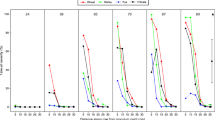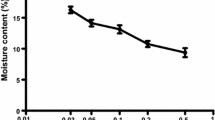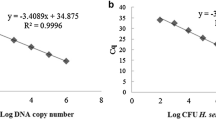Abstract
Two successive experiments described here show that the Mn-oxidizing ability of isolates of the take-all fungus Gaeumannomyces graminis var. tritici is positively correlated with the isolate virulence. Isolates of G. graminis var. tritici were screened for virulence on wheat in soil culture pot tests and visually scored for Mn-oxidizing capacity on agar plates. A comparison between experiments showed that the Mn-oxidizing ability of an isolate may be attenuated, as is virulence, with subculturing. Using a solution culture system, we calculated the rate of oxidation of Mn2+ by a virulent isolate, Ggt 500, as 4 nmol g-1 (dry weight hyphae) h-1. The significance of these results to the epidemiology of the take-all disease of wheat is discussed.
Similar content being viewed by others
References
Arnott H, Rosemann T, Graham RD, Huber DM (1991) An experimental study of manganese mineralization in the take-all fungus, Gaeumannomyces graminis. Mycol Soc Am Newsl 42:3
Asher MJC (1981) Pathogenic variation. In: Asher MJC, Shipton PJ (eds) Biology and control of take-all. academic Press, London, pp 199–217
Bromfield SM (1958a) Oxidation of manganese in soil by microorganisms. Aust J Biol Sci 9:238–252
Bromfield SM (1958b) The properties of a biologically formed Mn oxide, its availability to oats and its solution by root washings. Plant and Soil 9:325–337
Buchhorn SC, Graham RD (1992) The correlation of manganese oxidising ability of isolates of Gaeumannomyces graminis, var. tritici with their virulence as pathogenes of wheat roots. In: Commenorative volume in honour of Professor K.V.N. Rao. Andhra Pradesh Agricultural University, Rajendranagar, India, pp 13–22
Burnell JN (1988) The biochemistry of manganese in plants. In: Graham RD, Hannam RJ, Uren NC (eds) Manganese in soils and plants. Kluwer Academic Publishers, Dordrecht, pp 125–137
Dewan MM, Sivasithamparam K (1990) Differences in the pathogenicity of isolates of the take-all fungus from roots of wheat and ryegrass. Soil Biol Biochem 22:119–122
Genstat 5 Commitee (1987) GENSTAT 5: Reference manual 1987. Clarendon Press, Oxford
Gerretson FC (1937) Manganese deficiency of oats and its relation to soil bacteria. Ann Bot n. s. 1:207–230
Ghiorse WC (1988) The biology of manganese transforming microorganisms in soil. In: Graham RD, Hannam RJ, Uren NC (eds) Manganese in soils and plants. Kluwer Academic Publishers Dordrecht, pp 75–85
Graham RD (1983) Effects of nutrient stress on susceptibility of plants to disease with particular reference to the trace elements. Adv Bot Res 10:222–276
Graham RD, Rovira AD (1984) A role for manganese in the resistance of wheat plants to take all. Plant and Soil 78:441–444
Graham RD, Webb MJ (1991) Micronutrients and disease resistance and tolerance in plants. In: Mortvedt JJ, Cox FR, Shuman LM, Welch RM (eds) Micronutrients in agriculture, 2nd edn Soil Sci Soc Am, Madison, Wis, pp 329–370
Holden M, Ashby M (1978) Polygalacturonase production in liquid culture by isolates of Gaeumannomyces graminis and Phialophora-like fungi from cereal roots. Trans Br Mycol Soc 71:499–501
Huber DM, Wilhelm NS (1988) The role of manganese in disease resistance. In: Graham RD, Hannam RJ, Uren NC (eds) Manganese in soils and plants. Kluwer Academic Publishers, Dordrecht, pp 155–173
Leeper G (1970) Six trace elements in soils. Melbourne University Press, Melbourne
McDonald HJ, Rovira AD (1988) Tech Memo 12/85, CSIRO Division of Soils. Canberra, Australia
Northcote KH (1979) A factual key for the recognition of Australian soils. Rellim Tech Publ, Glenside, South Australia
Rosemann T, Graham RD, Arnott HA, Huber DM (1991) The interaction of temperature with virulence and manganese oxidizing potential in the epidemiology of Gaeumannomyces graminis. Phytopathology 81:1215
Timonin MI, Illman WI, Hartgerink T (1972) Oxidation of managenous salts by soil fungi. Can J Microbiol 18:793–799
Wilhelm NS (1992) Investigations into Gaeumannomyces graminis var tritici infection of manganese-deficient wheat. PhD thesis, University of Adelaide, Australia
Wilhelm NS, Graham RD, Rovira AD (1988) Application of different sources of manganese sulfate decreases take-all (Gaeumannomyces graminis var tritici) of wheat grown in a manganese deficient soil. Aust J Ag Res 39:1–10
Wilhelm NS, Graham RD, Rovira AD (1990) Control of Mn status and infection rate by genotype of both host and pathogen in the wheat take-all interaction. Plant and Soil 123:267–275
Zarcinas BA, Cartwright B (1983) Analysis of soil and plant material by inductively coupled plasma optical emission spectrometry. CSIRO Division of Soils, Tech Pap 45, Canberra, Australia
Author information
Authors and Affiliations
Rights and permissions
About this article
Cite this article
Pedler, J.F., Webb, M.J., Buchhorn, S.C. et al. Manganese-oxidizing ability of isolates of the take-all fungus is correlated with virulence. Biol Fert Soils 22, 272–278 (1996). https://doi.org/10.1007/BF00382524
Received:
Issue Date:
DOI: https://doi.org/10.1007/BF00382524




